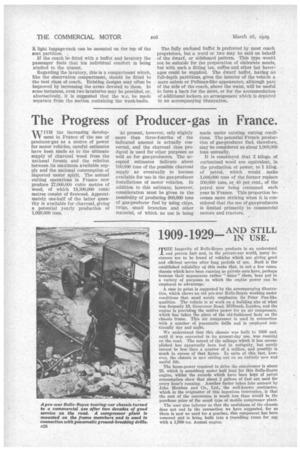The Progress of Producer-gas •in France.
Page 58

If you've noticed an error in this article please click here to report it so we can fix it.
TITII the increasing develop ' V ment in Prance of the use of producer-gas as a source of power for motor vehicles, careful estimates have been made as to the ultimate supply of charcoal wood from the national forests and the relation between its maximum available supply and the national consumption of imported motor spirit. The annual cutting operations in Prance now produce 27,000,000 cubic metres of wood, of which 18,500,000 cubic metres consist of firewood. Approximately one-half of the latter quantity is available for charcoal, giving a potential yearly production of 1,000,000 tons. At present, however, only slightly more than three-fourths of the indicated amount is actually converted, and the charcoal thus produced is used for other purposes as well as for gas-producers. The accepted estimates indicate about 700,000 tons of the possible charcoal supply as eventually to become available for use in the gas-producer installations of motor vehicles. In addition to this estimate, however, consideration must be given to the possibility of producing 300,000 tons of gas-producer fuel by using chips, twigs, small branches and other material, of which no use is being made under existing cutting conditions. The potential French production of gas-producer fuel, therefore, may be considered as about 1,000,000 tons annually.
It is considered that 2 kilogs. of carbonized wood are equivalent, in the production of power, to 1 kilog. of petrol, which would make 1,000,000 tons of the former replace 500,000 tons, or 40 per cent., of the petrol now being consumed. each year in France. This proportion becomes more striking when it is considered that the use of gas-producers is limited primarily to commercial motors and tractors.




























































































































